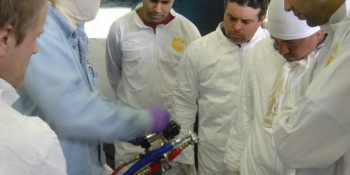Q&A Forums
heavy oil storage tanks Post New Topic | Post Reply
| Author | Comments |
|---|---|
|
Wayne Hawke
Posted: Oct 15, 2011 02:43 AM
|
heavy oil storage tanks
I have sprayed CC foam most of my working life.I like to think I can figure out most problems. I recently accepted a position spraying 1000 to 3000 barrel tanks in plant. Tanks are new to me so I followed the lead of the sprayer who had the experience. I immediately saw that completed tanks were showing blisters. Most were between passes and occurred after being placed in the yard. The tanks are coated black. There are no primers used and the total applied foam is 11/2" or 2". The tanks are placed on a mechanized turntable and access is by a scissor lift. It seemed asthetics were the primary goal.Multiple passes were applied in 6 to 8' lifts. The overspray was massive. The technique seemed flawed to me. Up and down strokes very quickly as the tank spins. The end result looked great, but the blisters followed after the sun heated them up. Demilac material was being applied and ultimately blamed for the problem. When the tanks are put into service, they are heated constantly(up to 180F) I predicted they would see many more failures after heat is applied. My experience made me want to alter the methods before I changed the system. I started spraying full thickness in a single pass figuring that exotherm, or lack of it was the culprit. I also heated any tank that I sprayed. We have switched to BASF Elastospray now. Do you think that multiple passes will still pose problems? The difference in yield alone should convince anyone who is paying for the foam that multiple passes costs a pile of cash. There are many companies building tanks in this area and driving around the countryside provides plenty of examples of foam that is not performing very well. Huge blisters, delamination, missing altogether. There are so many that I plan to start a business just going to wellsites repairing all the sad looking specimens.Any insight would be appreciated. I think I am on the right track. |
|
mason
Posted: Oct 15, 2011 10:11 PM
|
Tanks were one of the first applications that used sprayfoam in the early 60s. Just like you discovered, we found that spraying the foam in light lifts results in blisters. You need to spray in at the minimum 1/2 inch thick lifts. There is a high density skin formed between each lift that can cause a blister if there isn't enough foam separating the lifts. Plus the foam at the surface of the tank is expanding and contracting with the outside temperature at a different rate than the next lift of foam causing stress at the lift lines. So spray the foam in thicker lifts. Not only will you reduce the stress between the lifts, the foam will also be stronger. It takes a minimum amount of foam to obtain good cell structure. Again, at least 1/2 inch of foam. But don't spray it too thick or it will cause too much exothermic heat to develop. Then the foam cells will be deformed, have too many open cells, cause strong odors and also greater dimensional instability. Another thing, you should be using at least a 2.5 lb density foam to get the best dimensional stability. There is a tank and vessel guideline available at sprayfoam.org. It is in the technical section of their webpages |





























